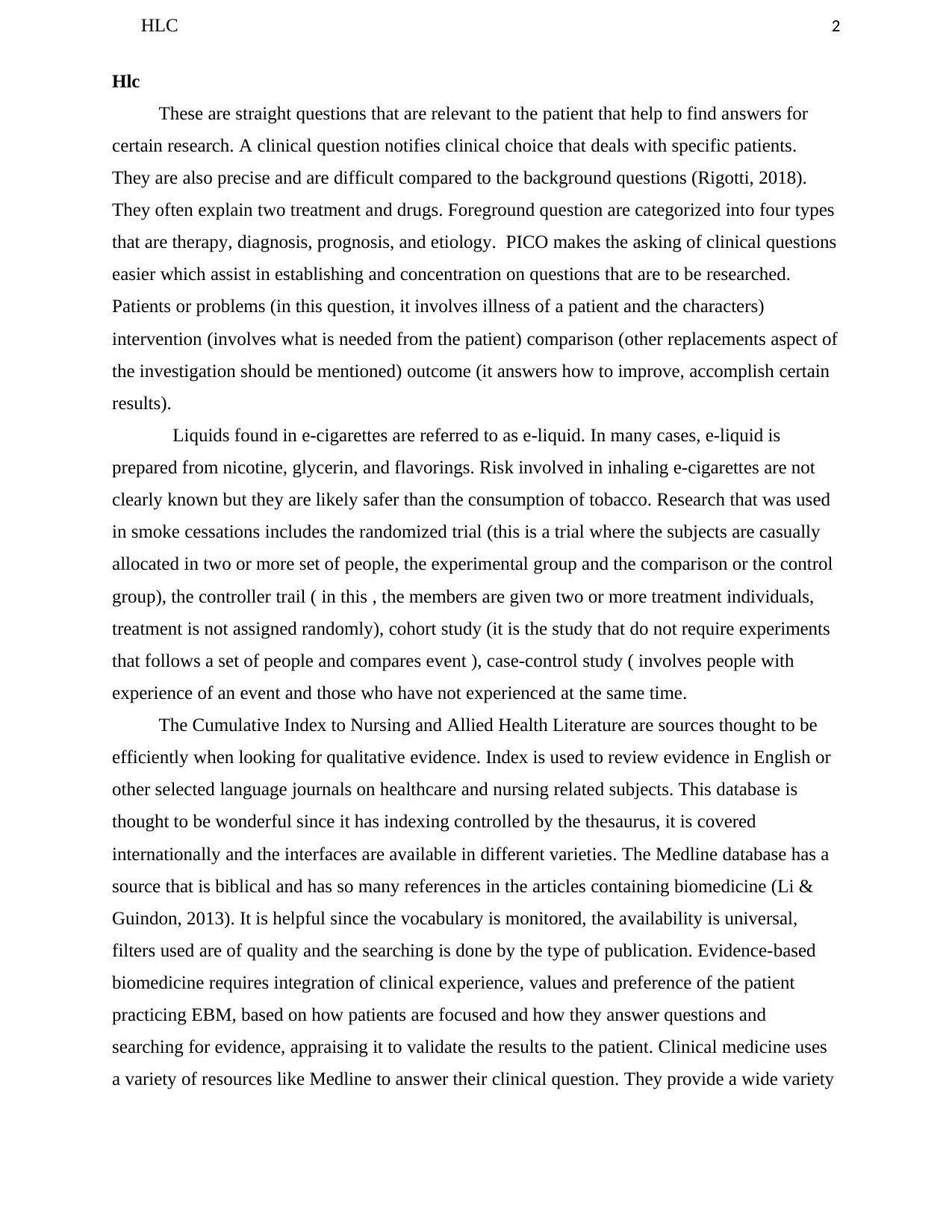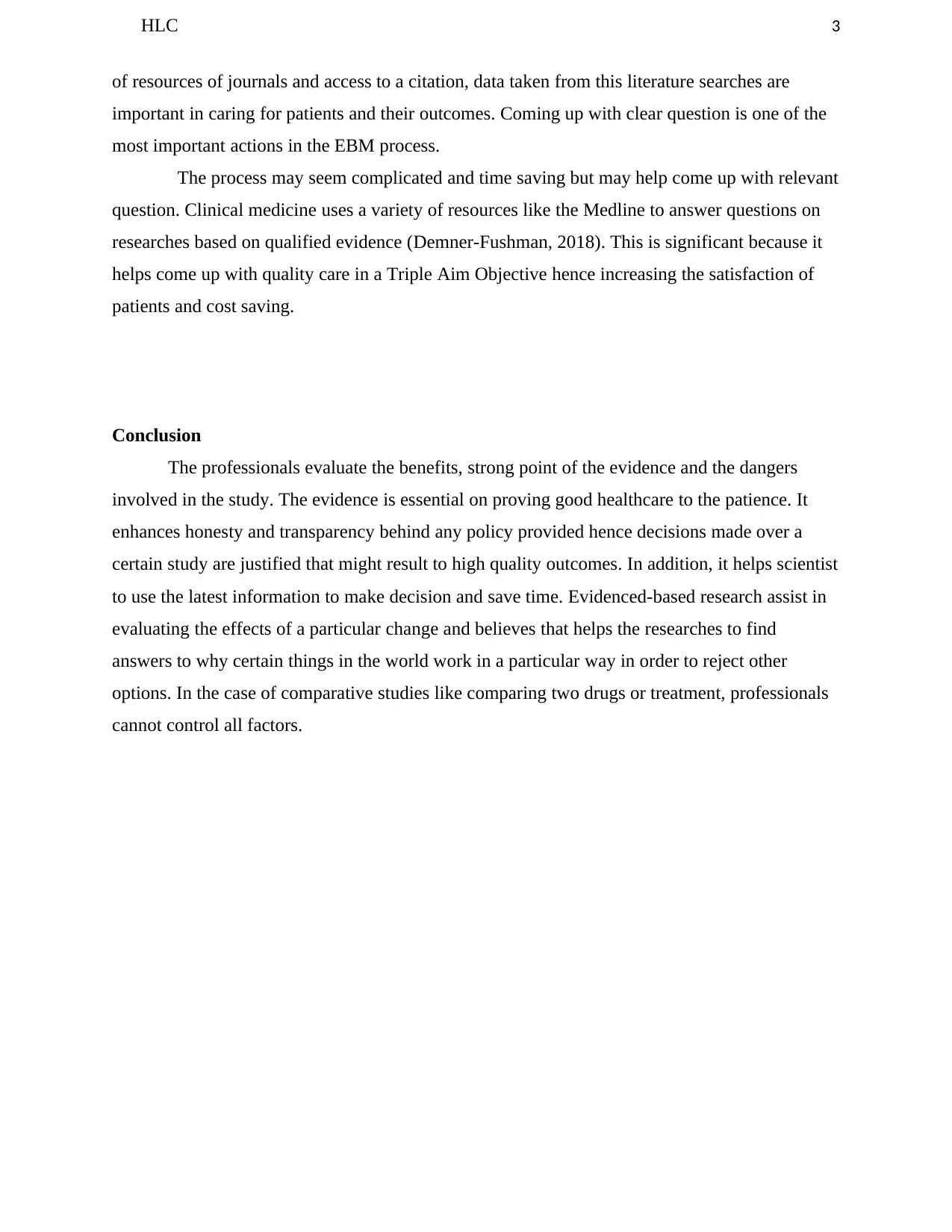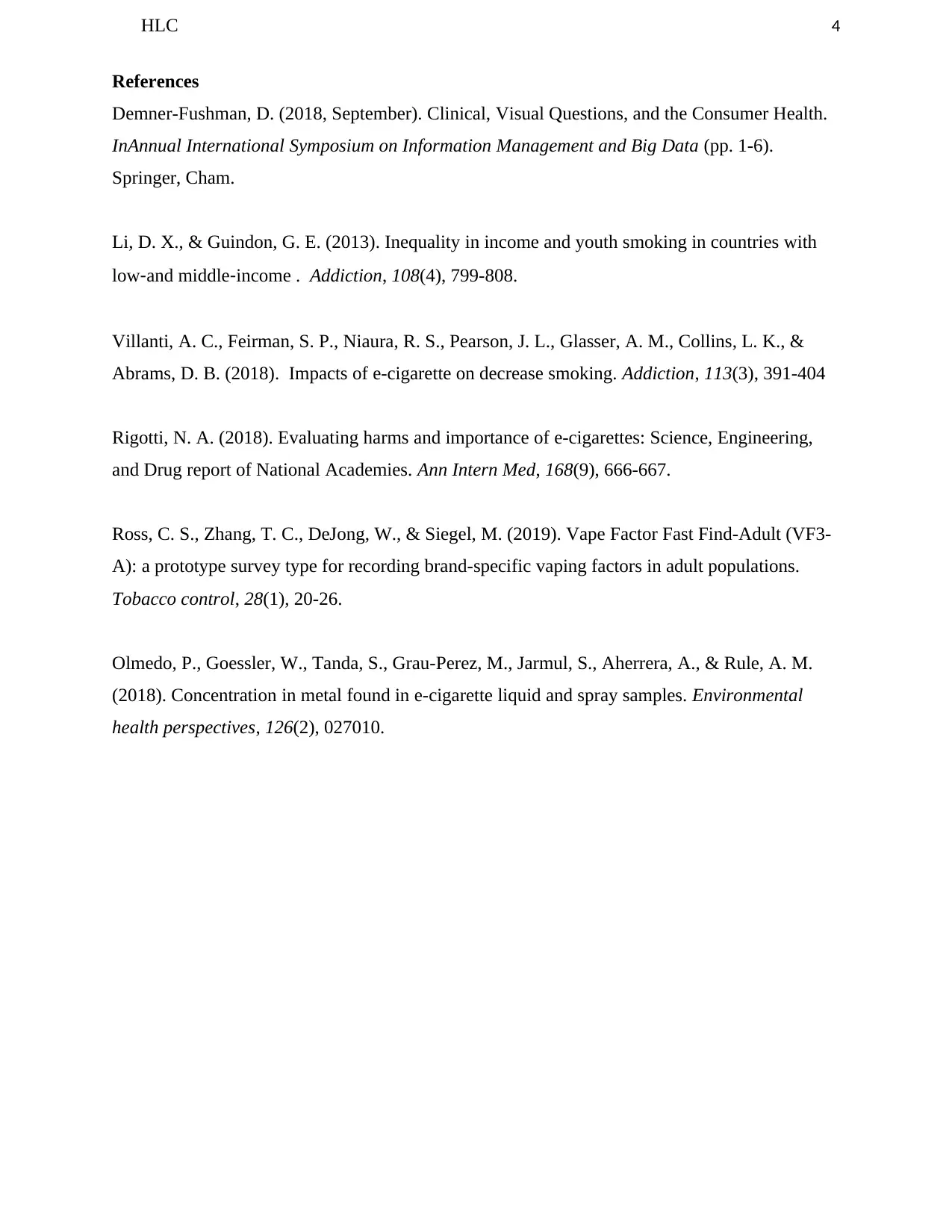University HLC Report: E-Cigarette Effectiveness in Smoking Cessation
VerifiedAdded on 2023/04/07
|4
|853
|102
Report
AI Summary
This report addresses a clinical question regarding the effectiveness of e-cigarettes compared to nicotine replacement therapies for smoking cessation in adults. The report follows the PICO framework, focusing on the patient population, intervention, comparison, and outcome. It explores various research methodologies like randomized trials, cohort studies, and case-control studies. The report highlights the importance of evidence-based medicine, emphasizing the use of databases like CINAHL and Medline to find relevant research articles, including systematic reviews and randomized controlled trials. The findings suggest that coming up with clear questions is an important step in the EBM process, which can improve patient outcomes. The conclusion evaluates the benefits and limitations of the study, emphasizing the importance of using the latest information and transparency in the research to improve patient care and outcomes.

Running head: HLC 1
Hlc
Students name:
Instructor:
University affiliation:
Date:
Hlc
Students name:
Instructor:
University affiliation:
Date:
Paraphrase This Document
Need a fresh take? Get an instant paraphrase of this document with our AI Paraphraser

HLC 2
Hlc
These are straight questions that are relevant to the patient that help to find answers for
certain research. A clinical question notifies clinical choice that deals with specific patients.
They are also precise and are difficult compared to the background questions (Rigotti, 2018).
They often explain two treatment and drugs. Foreground question are categorized into four types
that are therapy, diagnosis, prognosis, and etiology. PICO makes the asking of clinical questions
easier which assist in establishing and concentration on questions that are to be researched.
Patients or problems (in this question, it involves illness of a patient and the characters)
intervention (involves what is needed from the patient) comparison (other replacements aspect of
the investigation should be mentioned) outcome (it answers how to improve, accomplish certain
results).
Liquids found in e-cigarettes are referred to as e-liquid. In many cases, e-liquid is
prepared from nicotine, glycerin, and flavorings. Risk involved in inhaling e-cigarettes are not
clearly known but they are likely safer than the consumption of tobacco. Research that was used
in smoke cessations includes the randomized trial (this is a trial where the subjects are casually
allocated in two or more set of people, the experimental group and the comparison or the control
group), the controller trail ( in this , the members are given two or more treatment individuals,
treatment is not assigned randomly), cohort study (it is the study that do not require experiments
that follows a set of people and compares event ), case-control study ( involves people with
experience of an event and those who have not experienced at the same time.
The Cumulative Index to Nursing and Allied Health Literature are sources thought to be
efficiently when looking for qualitative evidence. Index is used to review evidence in English or
other selected language journals on healthcare and nursing related subjects. This database is
thought to be wonderful since it has indexing controlled by the thesaurus, it is covered
internationally and the interfaces are available in different varieties. The Medline database has a
source that is biblical and has so many references in the articles containing biomedicine (Li &
Guindon, 2013). It is helpful since the vocabulary is monitored, the availability is universal,
filters used are of quality and the searching is done by the type of publication. Evidence-based
biomedicine requires integration of clinical experience, values and preference of the patient
practicing EBM, based on how patients are focused and how they answer questions and
searching for evidence, appraising it to validate the results to the patient. Clinical medicine uses
a variety of resources like Medline to answer their clinical question. They provide a wide variety
Hlc
These are straight questions that are relevant to the patient that help to find answers for
certain research. A clinical question notifies clinical choice that deals with specific patients.
They are also precise and are difficult compared to the background questions (Rigotti, 2018).
They often explain two treatment and drugs. Foreground question are categorized into four types
that are therapy, diagnosis, prognosis, and etiology. PICO makes the asking of clinical questions
easier which assist in establishing and concentration on questions that are to be researched.
Patients or problems (in this question, it involves illness of a patient and the characters)
intervention (involves what is needed from the patient) comparison (other replacements aspect of
the investigation should be mentioned) outcome (it answers how to improve, accomplish certain
results).
Liquids found in e-cigarettes are referred to as e-liquid. In many cases, e-liquid is
prepared from nicotine, glycerin, and flavorings. Risk involved in inhaling e-cigarettes are not
clearly known but they are likely safer than the consumption of tobacco. Research that was used
in smoke cessations includes the randomized trial (this is a trial where the subjects are casually
allocated in two or more set of people, the experimental group and the comparison or the control
group), the controller trail ( in this , the members are given two or more treatment individuals,
treatment is not assigned randomly), cohort study (it is the study that do not require experiments
that follows a set of people and compares event ), case-control study ( involves people with
experience of an event and those who have not experienced at the same time.
The Cumulative Index to Nursing and Allied Health Literature are sources thought to be
efficiently when looking for qualitative evidence. Index is used to review evidence in English or
other selected language journals on healthcare and nursing related subjects. This database is
thought to be wonderful since it has indexing controlled by the thesaurus, it is covered
internationally and the interfaces are available in different varieties. The Medline database has a
source that is biblical and has so many references in the articles containing biomedicine (Li &
Guindon, 2013). It is helpful since the vocabulary is monitored, the availability is universal,
filters used are of quality and the searching is done by the type of publication. Evidence-based
biomedicine requires integration of clinical experience, values and preference of the patient
practicing EBM, based on how patients are focused and how they answer questions and
searching for evidence, appraising it to validate the results to the patient. Clinical medicine uses
a variety of resources like Medline to answer their clinical question. They provide a wide variety

HLC 3
of resources of journals and access to a citation, data taken from this literature searches are
important in caring for patients and their outcomes. Coming up with clear question is one of the
most important actions in the EBM process.
The process may seem complicated and time saving but may help come up with relevant
question. Clinical medicine uses a variety of resources like the Medline to answer questions on
researches based on qualified evidence (Demner-Fushman, 2018). This is significant because it
helps come up with quality care in a Triple Aim Objective hence increasing the satisfaction of
patients and cost saving.
Conclusion
The professionals evaluate the benefits, strong point of the evidence and the dangers
involved in the study. The evidence is essential on proving good healthcare to the patience. It
enhances honesty and transparency behind any policy provided hence decisions made over a
certain study are justified that might result to high quality outcomes. In addition, it helps scientist
to use the latest information to make decision and save time. Evidenced-based research assist in
evaluating the effects of a particular change and believes that helps the researches to find
answers to why certain things in the world work in a particular way in order to reject other
options. In the case of comparative studies like comparing two drugs or treatment, professionals
cannot control all factors.
of resources of journals and access to a citation, data taken from this literature searches are
important in caring for patients and their outcomes. Coming up with clear question is one of the
most important actions in the EBM process.
The process may seem complicated and time saving but may help come up with relevant
question. Clinical medicine uses a variety of resources like the Medline to answer questions on
researches based on qualified evidence (Demner-Fushman, 2018). This is significant because it
helps come up with quality care in a Triple Aim Objective hence increasing the satisfaction of
patients and cost saving.
Conclusion
The professionals evaluate the benefits, strong point of the evidence and the dangers
involved in the study. The evidence is essential on proving good healthcare to the patience. It
enhances honesty and transparency behind any policy provided hence decisions made over a
certain study are justified that might result to high quality outcomes. In addition, it helps scientist
to use the latest information to make decision and save time. Evidenced-based research assist in
evaluating the effects of a particular change and believes that helps the researches to find
answers to why certain things in the world work in a particular way in order to reject other
options. In the case of comparative studies like comparing two drugs or treatment, professionals
cannot control all factors.
⊘ This is a preview!⊘
Do you want full access?
Subscribe today to unlock all pages.

Trusted by 1+ million students worldwide

HLC 4
References
Demner-Fushman, D. (2018, September). Clinical, Visual Questions, and the Consumer Health.
InAnnual International Symposium on Information Management and Big Data (pp. 1-6).
Springer, Cham.
Li, D. X., & Guindon, G. E. (2013). Inequality in income and youth smoking in countries with
low‐and middle‐income . Addiction, 108(4), 799-808.
Villanti, A. C., Feirman, S. P., Niaura, R. S., Pearson, J. L., Glasser, A. M., Collins, L. K., &
Abrams, D. B. (2018). Impacts of e-cigarette on decrease smoking. Addiction, 113(3), 391-404
Rigotti, N. A. (2018). Evaluating harms and importance of e-cigarettes: Science, Engineering,
and Drug report of National Academies. Ann Intern Med, 168(9), 666-667.
Ross, C. S., Zhang, T. C., DeJong, W., & Siegel, M. (2019). Vape Factor Fast Find-Adult (VF3-
A): a prototype survey type for recording brand-specific vaping factors in adult populations.
Tobacco control, 28(1), 20-26.
Olmedo, P., Goessler, W., Tanda, S., Grau-Perez, M., Jarmul, S., Aherrera, A., & Rule, A. M.
(2018). Concentration in metal found in e-cigarette liquid and spray samples. Environmental
health perspectives, 126(2), 027010.
References
Demner-Fushman, D. (2018, September). Clinical, Visual Questions, and the Consumer Health.
InAnnual International Symposium on Information Management and Big Data (pp. 1-6).
Springer, Cham.
Li, D. X., & Guindon, G. E. (2013). Inequality in income and youth smoking in countries with
low‐and middle‐income . Addiction, 108(4), 799-808.
Villanti, A. C., Feirman, S. P., Niaura, R. S., Pearson, J. L., Glasser, A. M., Collins, L. K., &
Abrams, D. B. (2018). Impacts of e-cigarette on decrease smoking. Addiction, 113(3), 391-404
Rigotti, N. A. (2018). Evaluating harms and importance of e-cigarettes: Science, Engineering,
and Drug report of National Academies. Ann Intern Med, 168(9), 666-667.
Ross, C. S., Zhang, T. C., DeJong, W., & Siegel, M. (2019). Vape Factor Fast Find-Adult (VF3-
A): a prototype survey type for recording brand-specific vaping factors in adult populations.
Tobacco control, 28(1), 20-26.
Olmedo, P., Goessler, W., Tanda, S., Grau-Perez, M., Jarmul, S., Aherrera, A., & Rule, A. M.
(2018). Concentration in metal found in e-cigarette liquid and spray samples. Environmental
health perspectives, 126(2), 027010.
1 out of 4
Related Documents
Your All-in-One AI-Powered Toolkit for Academic Success.
+13062052269
info@desklib.com
Available 24*7 on WhatsApp / Email
![[object Object]](/_next/static/media/star-bottom.7253800d.svg)
Unlock your academic potential
Copyright © 2020–2025 A2Z Services. All Rights Reserved. Developed and managed by ZUCOL.





